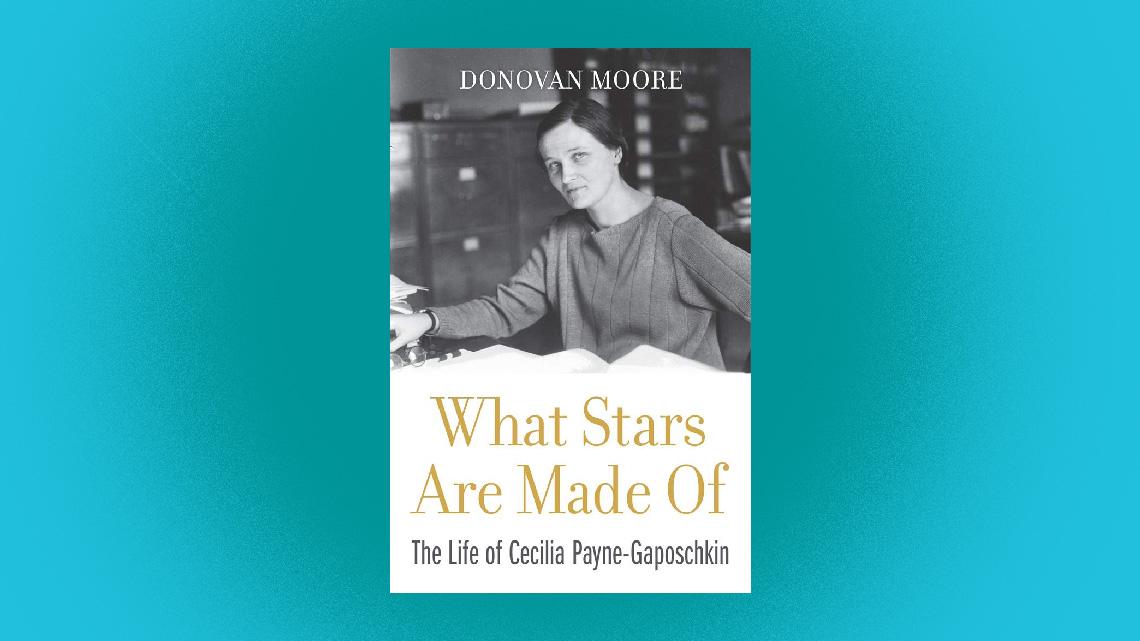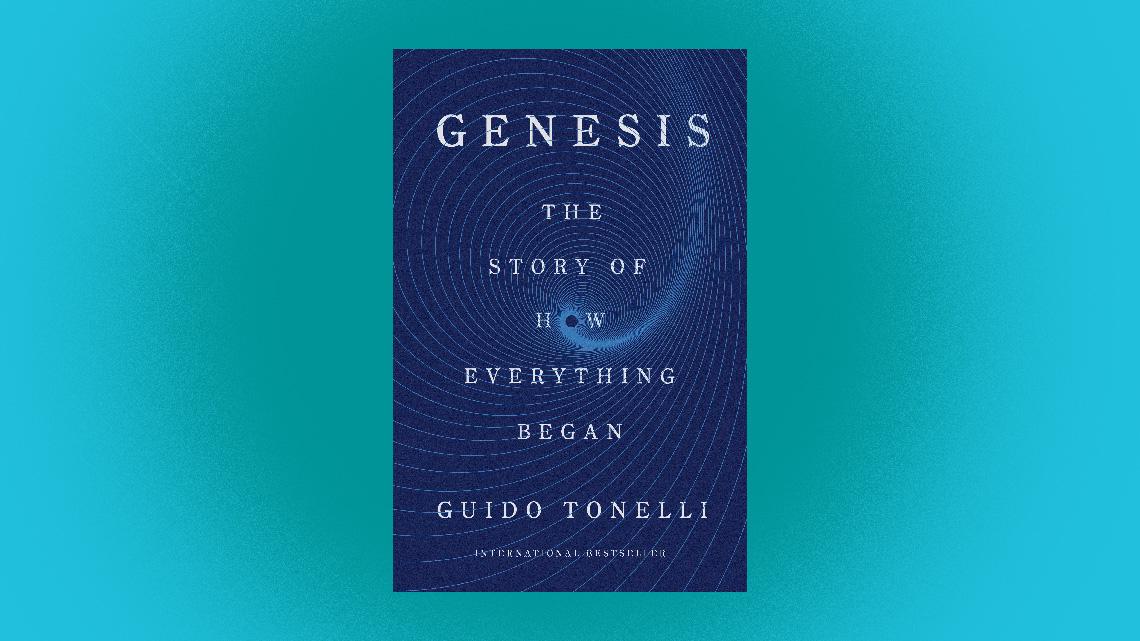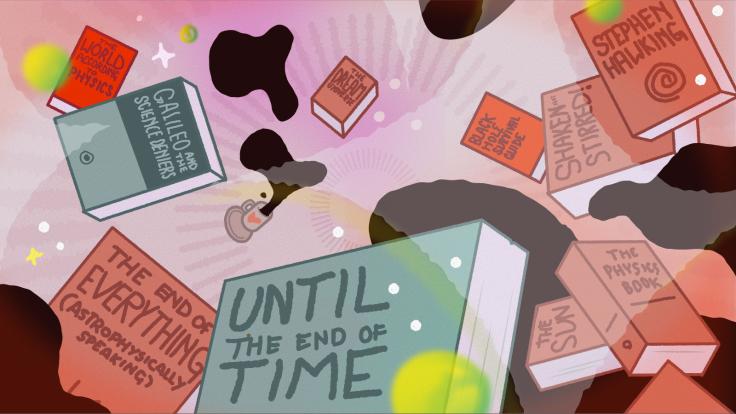Symmetry writer Mike Perricone is back again with a round-up of this year’s popular writing related to particle physics and astrophysics.
Several notable titles include explorations of what it’s like to be a woman in science, to be Black in science, or to live at the intersection of the two. These books explore the quest for a “theory of everything,” an acrimonious debate over the Big Bang theory, and the idealistic side of the scientist behind the first detection of neutrinos. They describe the life of physicist Stephen Hawking and the study of the origin of the universe, along with the mysteries of quantum theory and the complex realms of mathematics in science.

What Stars Are Made Of: The Life of Cecilia Payne-Gaposchkin, by Donovan Moore
In 1925, Cecilia Payne upended scientific consensus about the make-up of stars. Working with noted astronomer Harlow Shapley at the Harvard Observatory, Payne marked thousands of fragile glass photographic plates to catalogue the spectral lines of stars. She demonstrated that stars were made almost entirely of hydrogen and helium, contradicting the long-held assumption that the sun was composed of similar elements to the Earth. Although he acknowledged Payne, astronomer Otto Struve was subsequently given the credit by many for reaching the same conclusion. This is journalist Donovan Moore’s first science book.

The God Equation: The Quest for a Theory of Everything, by Michio Kaku
Theorist Michio Kaku (author of Beyond Einstein; Physics of the Future and others) echoes the name of physicist Leon Lederman’s popular science book The God Particle in the title to his new book, which surveys the search for a “theory of everything.” His exploration ranges from the Greek philosophers to Albert Einstein to the current proponents of the multiverse. Kaku’s money is on the theoretical framework he has worked on since 1968: string theory. Kaku is a professor of theoretical physics at City University of New York.

The Disordered Cosmos: A Journey into Dark Matter, Spacetime, & Dreams Deferred, by Chanda Prescod-Weinstein
Assistant Professor of Physics and Astronomy at the University of New Hampshire Chanda Prescod-Weinstein is “one of fewer than 100 Black American women to earn a PhD from a department of physics.” She writes forthrightly about the experience: “I learned quickly and painfully that physics and math classrooms are not only scenes of cosmology…but also scenes of society, complete with all of the problems that follow society wherever it goes.” Her love for cosmology and unique perspective on the subject shine through this important book.

Vera Rubin: A Life, by Jacqueline Mitton and Simon Mitton
Astronomer Vera Rubin—namesake of the forthcoming Vera C. Rubin Observatory in Chile—always explained that she did not “discover” dark matter. But it’s fair to say her work was the reason the scientific community began to take it seriously. From the 1960s to the 1980s, her observations of 60 spiral galaxies, including an exhaustive study of Andromeda, produced the flood of data needed to document dark matter’s existence and prominance in the cosmos. Authors Jacqueline and Simon Mitton have published more than 40 books on astronomy and the history of science.

Chasing the Ghost: Nobelist Fred Reines and the Neutrino, by Leonard A. Cole
In 1930, Wolfgang Pauli called the neutrino a “desperate remedy.” It was a chargeless, possibly massless and probably undetectable “ghost” of a particle that scientists invented to preserve the conservation of energy and momentum in radioactive decay. In 1956, Fred Reines and Clyde Cowan built a detector at the nuclear reactor in Savannah River, South Carolina, that finally successfully discovered it. Cowen passed away in 1974, but Reines was recognized with a portion of the 1995 Nobel Prize. In this biography/memoir, Leonard Coles (The Anthrax Letters), a younger cousin of Reines, talks about the life of his relative.

Fear of a Black Universe: An Outsider’s Guide to the Future of Physics, by Stephon Alexander
In studying dark matter and dark energy, cosmologist Stephon Alexander (author of The Jazz of Physics) advocates a bold, “outsider” approach. It helps that he has often felt like an outsider himself. As he explains, “Black persons in scientific circles are often met with skepticism about their intellectual abilities, their ability to ‘think like a physicist.’” The book’s title is a play on Public Enemy album Fear of a Black Planet, making it likely the only astrophysics book to contain a blurb by rapper Chuck D. A professor of physics at Brown University and former president of the National Society of Black Physicists, Alexander is also a saxophonist who has released two jazz albums.

Genesis: The Story of How Everything Began, by Guido Tonelli
From 2010-2011, physicist Guido Tonelli served as spokesperson for the CMS collaboration at the Large Hadron Collider, one of two experiments that in 2012 announced the discovery of the Higgs boson. In this book, he explores the origin of the universe in seven scientific epochs, modeled after the seven days of creation in the Biblical book of Genesis. He concludes that “the vision of the world that we have gradually developed through science is actually more amazing than anything we could have imagined before.” The late Erica Segre (1963-2021) and her husband, Simon Carnell, have created a near-lyrical translation from the original Italian.

Helgoland: Making Sense of the Quantum Revolution, by Carlo Rovelli
Helgoland is a treeless island in the North Sea where in 1930, a 23-year-old Werner Heisenberg sought both a relief from his allergies and a refuge where he could work on his theory of quantum mechanics. Theorist Carlo Rovelli (author of Seven Brief Lessons on Physics; The Order of Time, and others) validates both the difficulties and the opportunities in grappling with a theory that “predicts probability, not certainty” and a reality “of relations, rather than objects.” Another elegant translation from Italian by Segre and Carnell.

Hawking Hawking: The Selling of a Scientific Celebrity, by Charles Seife
Physicist Stephen Hawking’s early work on black holes and the radiation they emit made him “the scientific equivalent of the Beatles,” writes Charles Seife (author of Zero: The Biography of a Dangerous Idea, and five others). Over time, Hawking’s celebrity grew beyond the scientific community into pop culture as well. In this book, Seife explores Hawkings’ contradictions, describing him as a tireless self-promoter, “petulant, arrogant, and callous as well as warm, witty and brilliant.”

Flashes of Creation: George Gamow, Fred Hoyle, and the Great Big Bang Debate, by Paul Halpern
From the 1940s to the 1960s, the fierce debate over the origin of the universe was personified by the conflict between George Gamow and Fred Hoyle. Gamow trumpeted the idea of a “fiery creation,” whereas Hoyle saw the universe as an eternal steady state. Hoyle derisively nicknamed Gamow’s idea “the Big Bang,” an epithet that eventually became canon. Author Paul Halpern shows sympathy for Hoyle, pointing out that he was overlooked for his work on stars as generators of matter. Author of 17 popular science books (including The Quantum Labyrinth), Halpern is a professor of physics at the University of the Sciences in Philadelphia.

Math Without Numbers, by Milo Beckman
To non-experts dipping their toes into science, mathematics is often a show-stopper. With this book, mathematician Milo Beckman makes a wide range of math concepts accessible—without the numbers—through pattern recognition. Beckman partnered on the book with artist M Erazo, who visualizes each concept through a collection that adds up to almost 200 illustrations. Beckman’s own story is as compelling as his ideas: At age 8, he was already taking math classes at New York City’s prestigious Stuyvesant High School. At 16, he completed the graduate-level math sequence as a sophomore at Harvard. After working for a handful of tech companies and banks, Beckman retired at age 19. He has since taught math in New York, China and Brazil.













